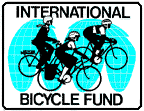Mali: Bicycle Tour Travel Guide

![]() IBF is 100%
IBF is 100%
solar powered
![]()
by David Mozer
[An introduction and overview to travel in Africa is available by clicking here. If you are look for a bicycle tour to this country, this link might help you.]
The information below may have been extracted from a more comprehensive "Country Supplement" to the book "Bicycling In Africa". For information on these publications click on the links.
Note: There has been increased terrorist activities in Mali since 2012. Attacks have occurred in Bamako, the Mopti region and north of the Niger River across most of the country. Check for the latest information if you plan to travel to any of these areas. (January 2019)
The Sahel is the broad savanna that runs along the southern edge of the Sahara. Bisecting the region is the Niger River The Strong Brown God Africa's third longest river and the life blood of central West Africa. Since the time of the great Mali and Songhai empires the Sahel has been the crossroads of West African trade. It is still host to people from all corners of the compass. On a market day it is not unusual to meet people from Senegal to Cameroon or from the Mediterranean Sea to the Bight of Benin. Proud Hausa, Djerma, Fulani, Wolof and Tuareg people regularly travel throughout the vast region each with their own traditions and distinctive culture. These, and other more sedentary ethnic groups, like the Dogon, represent some of Africa's most complex societies and most resistant to the imposition of Western institutions. The Sahel has a beauty and power all its own. You will share the road with camels, donkeys, sheep and horses.
Much of Mali is flat and uneventful. The main population centers are connected with paved roads, including the 1993 paving of the road into Djenne. Two exceptions are the area around Bandiagara / Sanga and between Bamako, Kita and Kayes. Both areas with bad roads are scenic and well suited to ATBs.
With the exception of the main national highway between Bamako and Segou (narrow with heavy traffic), any of the other directions out of Bamako can be used as a pleasant day trip or multi-day ride. There are villages and the activities of life on all the life. You have a choice between hilly routes to the north and flat routes to the south.
The easiest way into popular Dogon country and to Djenne is from Mopti. If you don't want to ride the entire way several bus companies make the 14 hour trip or from roughly September to December you can take a fascinating 2 day river boat from Koulikoro (60km east of Bamako) to Mopti. (It is best to store your bike along the back railing on the top deck and you shouldn't have to pay freight for it.)
If you plan to cycle between Mopti and Gao, be sure you are properly prepared. The road is improved and there is daily traffic, but still goes through some very desolate territory. The road from Gao to Niger is usually in bad conditions.
Note: When traveling in Mali you also need "visas" when visiting Timbuktu. Visit the police when you arrive. They will have you fill out another form and ask for a picture and some money. Bring some extra passport size pictures with you.
For more information on Mali see the publication Bicycle Touring In Mali, Burkina Faso and Niger.
Links of Interest:
Regional Resources:
Algeria
Burkina Faso
Cote d'Ivoire
Guinea
Mauritania
Niger
Senegal
For current news on Africa and more web sites with country-by-country information go to the link section and click on "Africa: News, Background, Travel."
Home | About Us | Contact Us | Contributions | Economics | Education | Encouragement | Engineering | Environment | Bibliography | Essay Contest | Ibike Tours | Library | Links | Site Map | Search
![]()
The International Bicycle Fund is an independent, non-profit organization. Its primary purpose is to promote bicycle transportation. Most IBF projects and activities fall into one of four categories: planning and engineering, safety education, economic development assistance and promoting international understanding. IBF's objective is to create a sustainable, people-friendly environment by creating opportunities of the highest practicable quality for bicycle transportation. IBF is funded by private donation. Contributions are always welcome and are U.S. tax-deductible to the extent allowed by law.
![]()
![]() Please write if you have questions, comment, criticism, praise or
additional information for us, to report bad links, or if you would like to be
added to IBF's mailing list. (Also let us know how you found this site.)
Please write if you have questions, comment, criticism, praise or
additional information for us, to report bad links, or if you would like to be
added to IBF's mailing list. (Also let us know how you found this site.)
